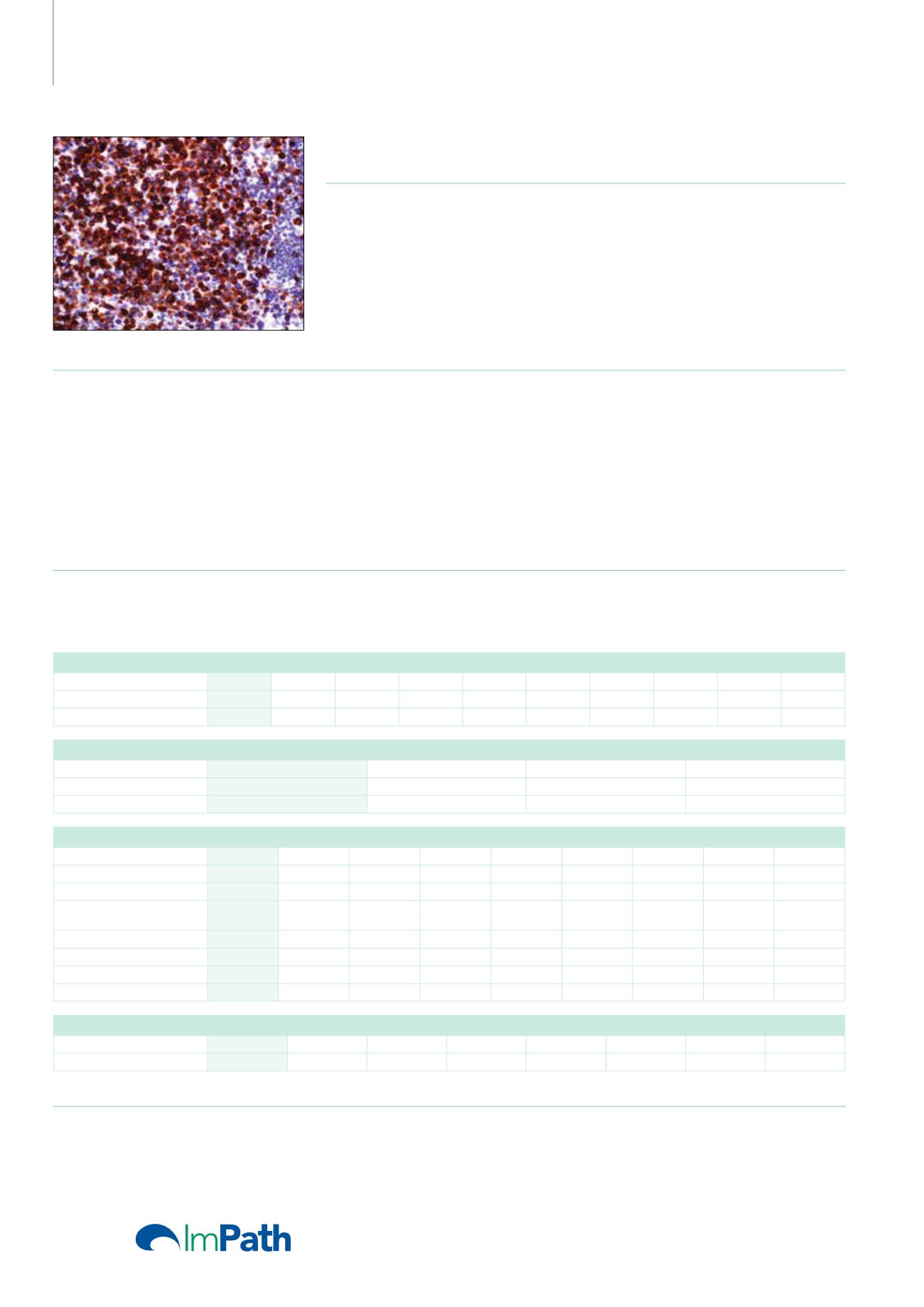
Antibodies for
Immunohistochemistry
CD3 (MRQ-39)
Rabbit Monoclonal Antibody
Cat. No. Description
Volume
45179 IMPATH CD3 (MRQ-39)
50 Tests
44231 CD3 RTU R (MRQ-39)
7 ml Ready To Use
44484 CD3 0,1 R (MRQ-39)
100 µl liquid Concentrated
44485 CD3 1 R (MRQ-39)
1 ml liquid Concentrated
Product Specifications
Designation
IVD
Reactivity
Paraffin
Visualization
Membranous
Control
Tonsil
Stability
Up to 36 mo. at 2-8°C
Isotype
IgG
Manual Protocol*
• Pretreatment: Heat Induced Epitope
Retrieval (HIER)
• Primary Antibody Incubation Time:
10-30min @ 25-37°C
• 2-step polymer detection
*Please refer to product insert for complete protocol.
ImPath Protocol*
• Dewax: Dewax Solution 2 (DS2)
• Pretreatment: Retrieval Solution pH 9.0
(TR1) 32min @ 98-103°C
• Primary Antibody Incubation Time:
10-90min @ 25-37°C
• HRP Polymer (Universal) or AP Polymer
(Universal) for 12 min
*Please refer to product insert for complete protocol.
Product Description
Anti-CD3 is considered to be a pan-T-cell marker. Anti-CD3 reacts with an antigen present at the surface and in the cytoplasm of the
T lymphocytes. The antibody for immunohistochemical detection locates the cytoplasmic component of CD3 protein. Anti-CD3 is widely used
in detection of T-cell malignancies, both immature and mature.
Lymphoblastic Lymphomas, B-cell vs. T-cell
CD3
TdT
CD10
PAX-5
CD20
CD19
CD5
CD7
CD117 CD1a
B-cell
-
+
+
+
+/-
+
-
-
-
+
T-cell
+
+
+/-
-
-
-
+/-
+/-
-/+
+/-
Lymphoma
CD3
CD20
CD45R
CD45RO
Mature B-cell
-
+
+
-
Mature T-cell
+
-
-
+
T-cell Lymphomas
CD3
CD45
CD2
CD4
CD5
CD7
CD8
CD25
PD-1
Angioimmunoblastic
+
+
+
+
+
+
-
+
+
Lymphoblastic
+
+
+/-
+/-
+
+
+/-
+
-
Subcutaneous
Panniculitis-Like
+
+
+
-
+
+
+/-
-
-
NK
+
+
+
-
-
-/+
-
+
-
Cutaneous
+
+
+
+
-
+
-
-
-/+
Peripheral, NOS
+
+
+
+/-
+/-
+/-
-/+
+
-
Mycosis Fungoides
+
+
+
+
+
-
-
+
-
Histiocytic Neoplasms
CD3
CD45
CD4
CD68
Lysozyme
CD163 Factor XIIIa
CD20
Histiocytic Neoplasms
-
+
+
+
+
+
+
-
Reference
1. Denning SM, et al. Oxford Univ. Press. 1987; 144-147.
2. Beverley PCL, et al. European J of Immunology. 11:329-334.
3. Clevers H, et al. European J of Immunology. 1988; 18:705-710.
46


